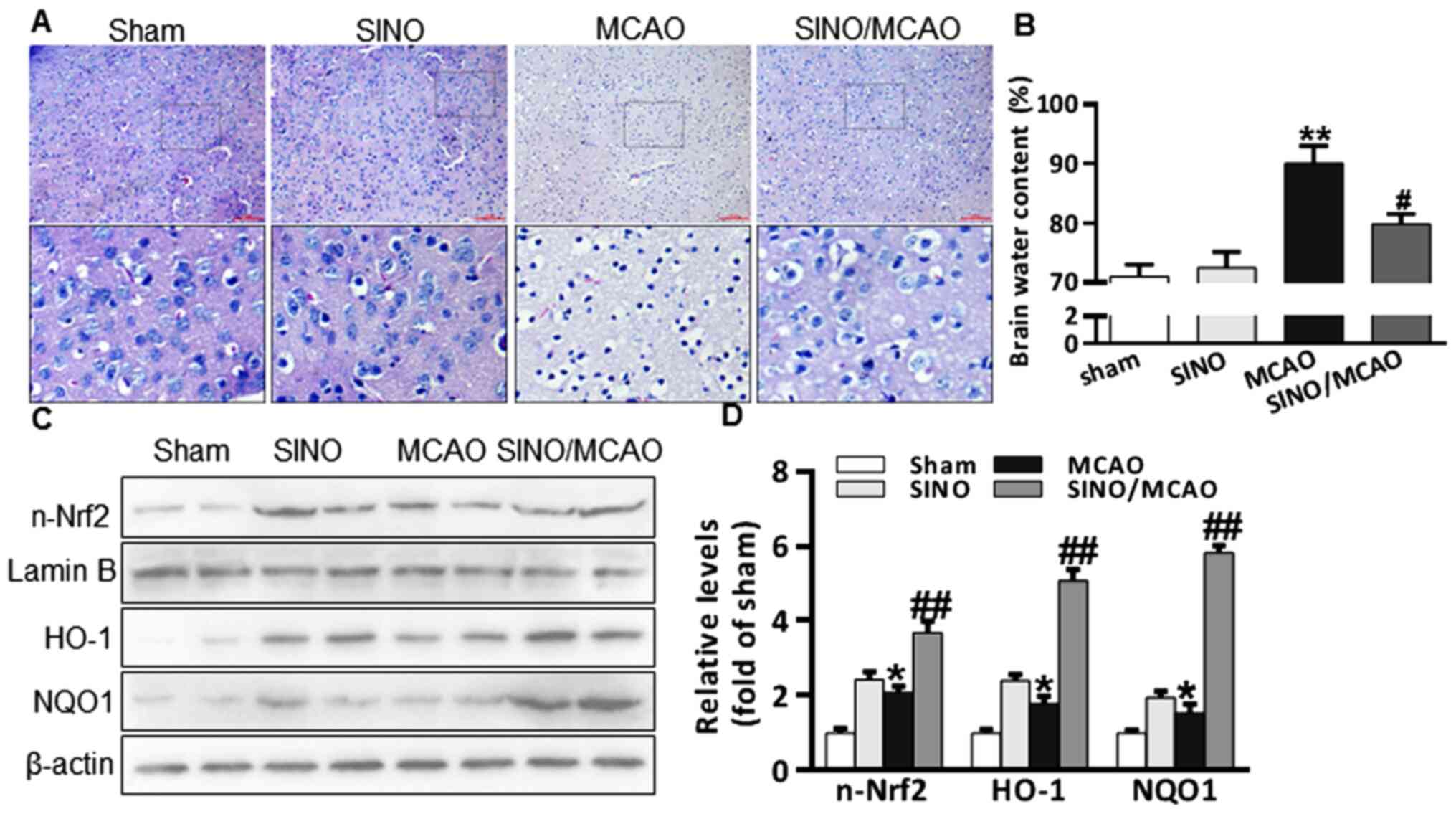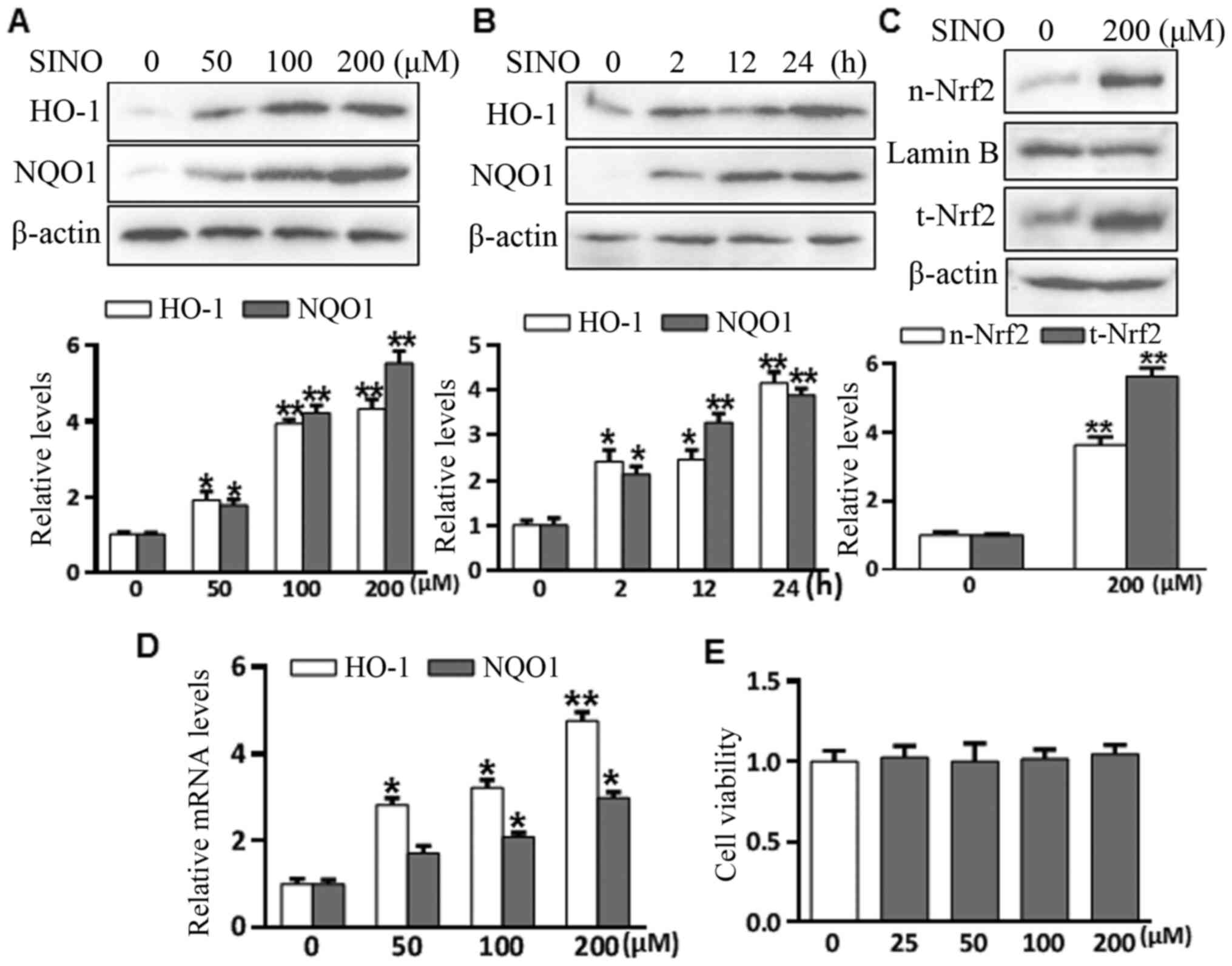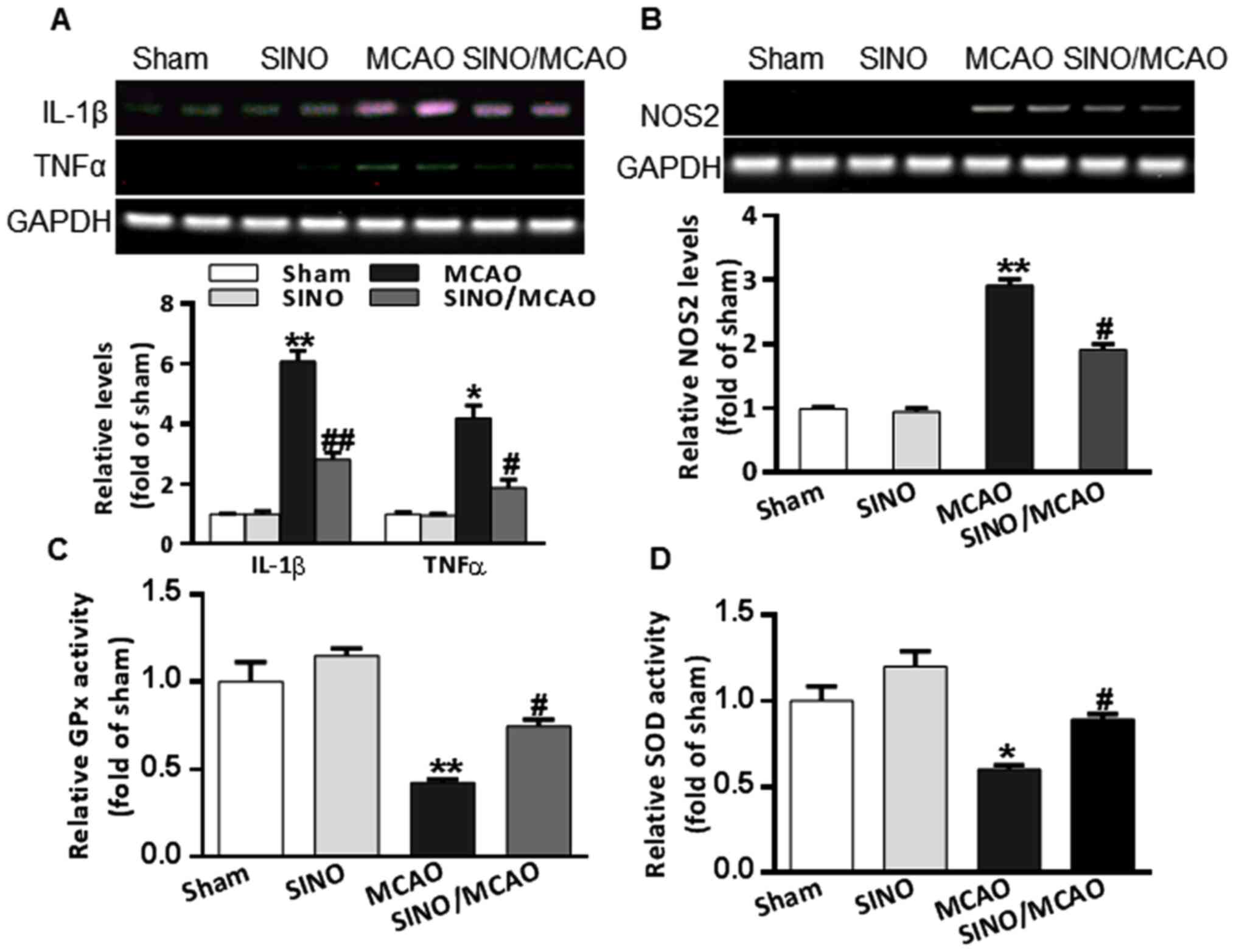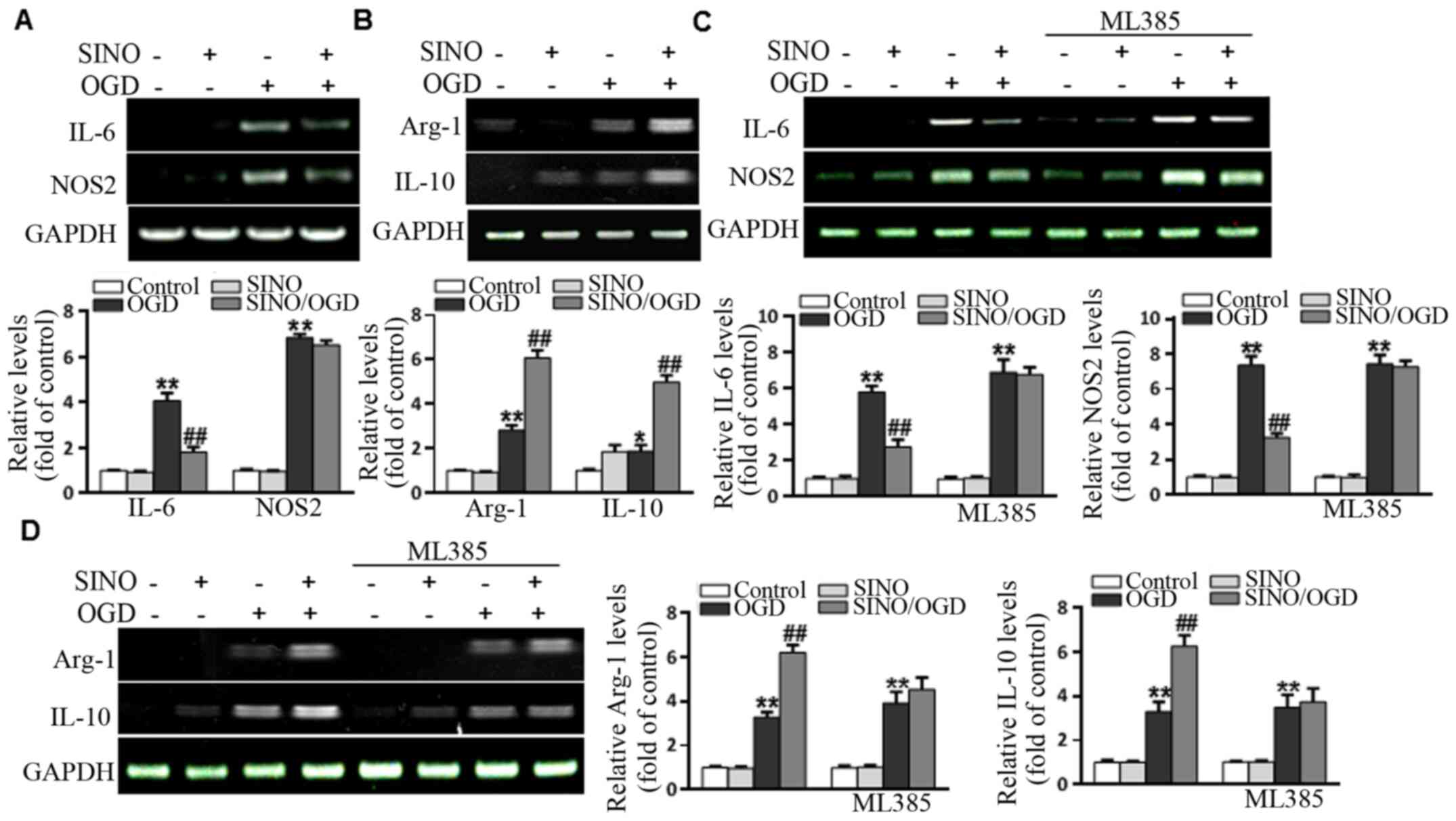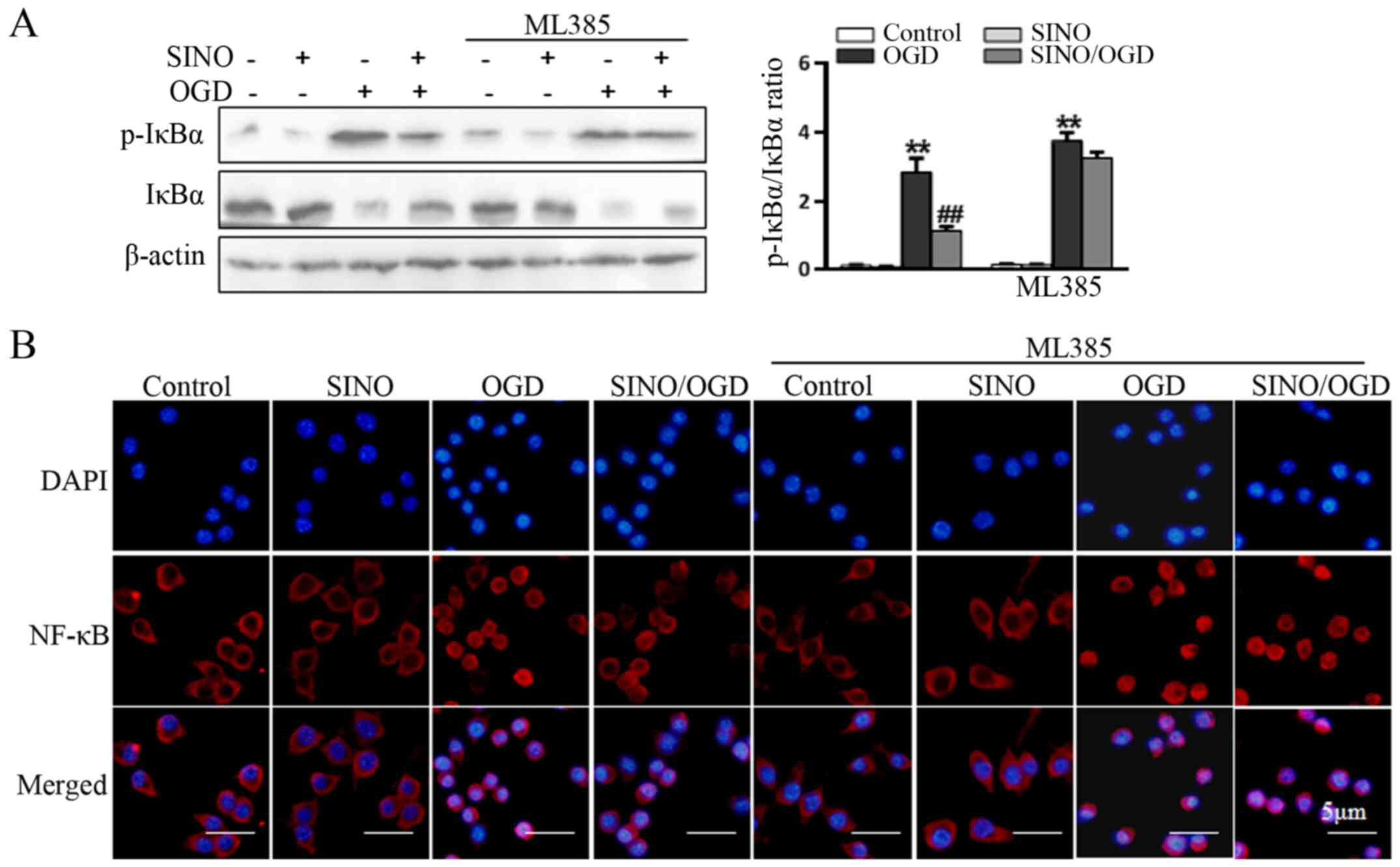|
1
|
Jeon JH, Jung HW, Jang HM, Moon JH, Park
KT, Lee HC, Lim HY, Sur JH, Kang BT, Ha J and Jung DI: Canine model
of ischemic stroke with permanent middle cerebral artery occlusion:
Clinical features, magnetic resonance imaging, histopathology, and
immunohistochemistry. J Vet Sci. 16:75–85. 2015.PubMed/NCBI View Article : Google Scholar
|
|
2
|
Ito M, Shichita T, Okada M, Komine R,
Noguchi Y, Yoshimura A and Morita R: Bruton's tyrosine kinase is
essential for NLRP3 inflammasome activation and contributes to
ischaemic brain injury. Nat Commun. 6(7360)2015.PubMed/NCBI View Article : Google Scholar
|
|
3
|
Fu Y, Liu Q, Anrather J and Shi FD: Immune
interventions in stroke. Nat Rev Neurol. 11:524–535.
2015.PubMed/NCBI View Article : Google Scholar
|
|
4
|
Pont-Lezica L, Bechade C, Belarif-Cantaut
Y, Pascual O and Bessis A: Physiological roles of microglia during
development. J Neurochem. 119:901–908. 2011.PubMed/NCBI View Article : Google Scholar
|
|
5
|
Subhramanyam CS, Wang C, Hu Q and Dheen
ST: Microglia-mediated neuroinflammation in neurodegenerative
diseases. Semin Cell Dev Biol. 94:112–120. 2019.PubMed/NCBI View Article : Google Scholar
|
|
6
|
Xu L, He D and Bai Y: Microglia-Mediated
inflammation and neurodegenerative disease. Mol Neurobiol.
53:6709–6715. 2016.PubMed/NCBI View Article : Google Scholar
|
|
7
|
Dong YF, Chen ZZ, Zhao Z, Yang DD, Yan H,
Ji J and Sun XL: Potential role of microRNA-7 in the
anti-neuroinflammation effects of nicorandil in astrocytes induced
by oxygen-glucose deprivation. J Neuroinflammation.
13(60)2016.PubMed/NCBI View Article : Google Scholar
|
|
8
|
Qin C, Zhou LQ, Ma XT, Hu ZW, Yang S, Chen
M, Bosco DB, Wu LJ and Tian DS: Dual functions of microglia in
ischemic stroke. Neurosci Bull. 35:921–933. 2019.PubMed/NCBI View Article : Google Scholar
|
|
9
|
Skowron MA, Niegisch G, Albrecht P, van
Koeveringe G, Romano A, Albers P, Schulz WA and Hoffmann MJ:
Various mechanisms involve the nuclear factor (Erythroid-Derived
2)-Like (NRF2) to achieve cytoprotection in long-term
cisplatin-treated urothelial carcinoma cell lines. Int J Mol Sci.
18(1680)2017.PubMed/NCBI View Article : Google Scholar
|
|
10
|
Fao L, Mota SI and Rego AC: Shaping the
Nrf2-ARE-related pathways in Alzheimer's and Parkinson's diseases.
Ageing Res Rev. 54(100942)2019.PubMed/NCBI View Article : Google Scholar
|
|
11
|
Robledinos-Anton N, Fernandez-Gines R,
Manda G and Cuadrado A: Activators and Inhibitors of NRF2: A review
of their potential for clinical development. Oxid Med Cell Longev.
2019(9372182)2019.PubMed/NCBI View Article : Google Scholar
|
|
12
|
Song S, Shen X, Tang Y, Wang Z, Guo W,
Ding G, Wang Q and Fu Z: Sinomenine pretreatment attenuates cold
ischemia/reperfusion injury in rats: The role of heme oxygenase-1.
Int Immunopharmacol. 10:679–684. 2010.PubMed/NCBI View Article : Google Scholar
|
|
13
|
Ko WC, Shieh JM and Wu WB: P38 MAPK and
Nrf2 activation mediated naked gold nanoparticle induced heme
oxygenase-1 expression in rat aortic vascular smooth muscle cells.
Arch Med Res. 51:388–396. 2020.PubMed/NCBI View Article : Google Scholar
|
|
14
|
Zhao Z, Xiao J, Wang J, Dong W, Peng Z and
An D: Anti-inflammatory effects of novel sinomenine derivatives.
Int Immunopharmacol. 29:354–360. 2015.PubMed/NCBI View Article : Google Scholar
|
|
15
|
Cheng Y, Li F, Wang D, Zhang Y, Yuan F and
Zhang J: Sinomenine inhibits the expression of PD-L1 in the
peripheral blood mononuclear cells of mesangial proliferative
nephritis patients. Mol Med Rep. 7:1223–1228. 2013.PubMed/NCBI View Article : Google Scholar
|
|
16
|
Shen Q, Zhang X, Qi J, Shu G, Du Y and
Ying X: Sinomenine hydrochloride loaded thermosensitive liposomes
combined with microwave hyperthermia for the treatment of
rheumatoid arthritis. Int J Pharm. 576(119001)2020.PubMed/NCBI View Article : Google Scholar
|
|
17
|
Tang J, Raza A, Chen J and Xu H: A
systematic review on the sinomenine derivatives. Mini Rev Med Chem.
18:906–917. 2018.PubMed/NCBI View Article : Google Scholar
|
|
18
|
Wang Q and Li XK: Immunosuppressive and
anti-inflammatory activities of sinomenine. Int Immunopharmacol.
11:373–376. 2011.PubMed/NCBI View Article : Google Scholar
|
|
19
|
Jiang Y, Gao M, Wang W, Lang Y, Tong Z,
Wang K, Zhang H, Chen G, Liu M, Yao Y and Xiao X: Sinomenine
hydrochloride protects against polymicrobial sepsis via autophagy.
Int J Mol Sci. 16:2559–2573. 2015.PubMed/NCBI View Article : Google Scholar
|
|
20
|
Qian L, Xu Z, Zhang W, Wilson B, Hong JS
and Flood PM: Sinomenine, a natural dextrorotatory morphinan
analog, is anti-inflammatory and neuroprotective through inhibition
of microglial NADPH oxidase. J Neuroinflammation.
4(23)2007.PubMed/NCBI View Article : Google Scholar
|
|
21
|
Sun Y, Yao Y and Ding CZ: A combination of
sinomenine and methotrexate reduces joint damage of collagen
induced arthritis in rats by modulating osteoclast-related
cytokines. Int Immunopharmacol. 18:135–141. 2014.PubMed/NCBI View Article : Google Scholar
|
|
22
|
Liu S, Chen Q, Liu J, Yang X, Zhang Y and
Huang F: Sinomenine protects against E. coli-induced acute
lung injury in mice through Nrf2-NF-κB pathway. Biomed
Pharmacother. 107:696–702. 2018.PubMed/NCBI View Article : Google Scholar
|
|
23
|
Wang Y, Yu C and Zhang H:
Lipopolysaccharides-mediated injury to chondrogenic ATDC5 cells can
be relieved by Sinomenine via downregulating microRNA-192.
Phytother Res. 33:1827–1836. 2019.PubMed/NCBI View
Article : Google Scholar
|
|
24
|
Bickler PE, Clark JP, Gabatto P and
Brosnan H: Hypoxic preconditioning and cell death from
oxygen/glucose deprivation co-opt a subset of the unfolded protein
response in hippocampal neurons. Neuroscience. 310:306–321.
2015.PubMed/NCBI View Article : Google Scholar
|
|
25
|
Liu Y, Lu L, Hettinger CL, Dong G, Zhang
D, Rezvani K, Wang X and Wang H: Ubiquilin-1 protects cells from
oxidative stress and ischemic stroke caused tissue injury in mice.
J Neurosci. 34:2813–2821. 2014.PubMed/NCBI View Article : Google Scholar
|
|
26
|
Wu WN, Wu PF, Chen XL, Zhang Z, Gu J, Yang
YJ, Xiong QJ, Ni L, Wang F and Chen JG: Sinomenine protects against
ischaemic brain injury: Involvement of co-inhibition of
acid-sensing ion channel 1a and L-type calcium channels. Br J
Pharmacol. 164:1445–1459. 2011.PubMed/NCBI View Article : Google Scholar
|
|
27
|
Qiu J, Yan Z, Tao K, Li Y, Li Y, Li J,
Dong Y, Feng D and Chen H: Sinomenine activates astrocytic dopamine
D2 receptors and alleviates neuroinflammatory injury via the
CRYAB/STAT3 pathway after ischemic stroke in mice. J
Neuroinflammation. 13(263)2016.PubMed/NCBI View Article : Google Scholar
|
|
28
|
Bi F, Chen F, Li Y, Wei A and Cao W:
Klotho preservation by Rhein promotes toll-like receptor 4
proteolysis and attenuates lipopolysaccharide-induced acute kidney
injury. J Mol Med (Berl). 96:915–927. 2018.PubMed/NCBI View Article : Google Scholar
|
|
29
|
Wang B, Tian S, Wang J, Han F, Zhao L,
Wang R, Ning W, Chen W and Qu Y: Intraperitoneal administration of
thioredoxin decreases brain damage from ischemic stroke. Brain Res.
1615:89–97. 2015.PubMed/NCBI View Article : Google Scholar
|
|
30
|
Qin T, Du R, Huang F, Yin S, Yang J, Qin S
and Cao W: Sinomenine activation of Nrf2 signaling prevents
hyperactive inflammation and kidney injury in a mouse model of
obstructive nephropathy. Free Radic Biol Med. 92:90–99.
2016.PubMed/NCBI View Article : Google Scholar
|
|
31
|
Livak KJ and Schmittgen TD: Analysis of
relative gene expression data using real-time quantitative PCR and
the 2(-Delta Delta C(T)) method. Methods. 25:402–408.
2001.PubMed/NCBI View Article : Google Scholar
|
|
32
|
Yin S and Cao W: Toll-like receptor
signaling induces Nrf2 pathway activation through p62-Triggered
Keap1 degradation. Mol Cell Biol. 35:2673–2683. 2015.PubMed/NCBI View Article : Google Scholar
|
|
33
|
Liu Q, Zhang F, Zhang X, Cheng R, Ma JX,
Yi J and Li J: Fenofibrate ameliorates diabetic retinopathy by
modulating Nrf2 signaling and NLRP3 inflammasome activation. Mol
Cell Biochem. 445:105–115. 2018.PubMed/NCBI View Article : Google Scholar
|
|
34
|
Wan JJ, Wang PY, Zhang Y, Qin Z, Sun Y, Hu
BH, Su DF, Xu DP and Liu X: Role of acute-phase protein ORM in a
mice model of ischemic stroke. J Cell Physiol. 234:20533–20545.
2019.PubMed/NCBI View Article : Google Scholar
|
|
35
|
Zhang F, Zhang JG, Yang W, Xu P, Xiao YL
and Zhang HT: 6-Gingerol attenuates LPS-induced neuroinflammation
and cognitive impairment partially via suppressing astrocyte
overactivation. Biomed Pharmacother. 107:1523–1529. 2018.PubMed/NCBI View Article : Google Scholar
|
|
36
|
Zalewska-Ziob M, Adamek B, Kasperczyk J,
Romuk E, Hudziec E, Chwalińska E, Dobija-Kubica K, Rogoziński P and
Bruliński K: Activity of antioxidant enzymes in the tumor and
adjacent noncancerous tissues of non-small-cell lung cancer. Oxid
Med Cell Longev. 2019(2901840)2019.PubMed/NCBI View Article : Google Scholar
|
|
37
|
Virani SS, Alonso A, Benjamin EJ,
Bittencourt MS, Callaway CW, Carson AP, Chamberlain AM, Chang AR,
Cheng S, Delling FN, et al: Heart disease and stroke
statistics-2020 update: A report from the American heart
association. Circulation. 141:e139–e596. 2020.PubMed/NCBI View Article : Google Scholar
|
|
38
|
Kernan WN, Ovbiagele B, Black HR, Bravata
DM, Chimowitz MI, Ezekowitz MD, Fang MC, Fisher M, Furie KL, Heck
DV, et al: Guidelines for the prevention of stroke in patients with
stroke and transient ischemic attack: A guideline for healthcare
professionals from the American heart association/American stroke
association. Stroke. 45:2160–2236. 2014.PubMed/NCBI View Article : Google Scholar
|
|
39
|
Go AS, Mozaffarian D, Roger VL, Benjamin
EJ, Berry JD, Blaha MJ, Dai S, Ford ES, Fox CS, Franco S, et al:
Heart disease and stroke statistics-2014 update: A report from the
American heart association. Circulation. 129:e28–e292.
2014.PubMed/NCBI View Article : Google Scholar
|
|
40
|
Khoshnam SE, Winlow W, Farbood Y,
Moghaddam HF and Farzaneh M: Emerging roles of microRNAs in
ischemic stroke: As possible therapeutic agents. J Stroke.
19:166–187. 2017.PubMed/NCBI View Article : Google Scholar
|
|
41
|
Li WX, Qi F, Liu JQ, Li GH, Dai SX, Zhang
T, Cheng F, Liu D and Zheng SG: Different impairment of immune and
inflammation functions in short and long-term after ischemic
stroke. Am J Transl Res. 9:736–745. 2017.PubMed/NCBI
|
|
42
|
Cowan M and Petri WA Jr: Microglia: Immune
regulators of neurodevelopment. Front Immunol.
9(2576)2018.PubMed/NCBI View Article : Google Scholar
|
|
43
|
Lee JH, Wei ZZ, Cao W, Won S, Gu X, Winter
M, Dix TA, Wei L and Yu SP: Regulation of therapeutic hypothermia
on inflammatory cytokines, microglia polarization, migration and
functional recovery after ischemic stroke in mice. Neurobiol Dis.
96:248–260. 2016.PubMed/NCBI View Article : Google Scholar
|
|
44
|
Wu HY, Tang XQ, Liu H, Mao XF and Wang YX:
Both classic Gs-cAMP/PKA/CREB and alternative
Gs-cAMP/PKA/p38beta/CREB signal pathways mediate
exenatide-stimulated expression of M2 microglial markers. J
Neuroimmunol. 316:17–22. 2018.PubMed/NCBI View Article : Google Scholar
|
|
45
|
Wu HY, Tang XQ, Mao XF and Wang YX:
Autocrine interleukin-10 mediates glucagon-like peptide-1
receptor-induced spinal microglial β-endorphin expression. J
Neurosci. 37:11701–11714. 2017.PubMed/NCBI View Article : Google Scholar
|
|
46
|
Miao H, Li R, Han C, Lu X and Zhang H:
Minocycline promotes posthemorrhagic neurogenesis via M2 microglia
polarization via upregulation of the TrkB/BDNF pathway in rats. J
Neurophysiol. 120:1307–1317. 2018.PubMed/NCBI View Article : Google Scholar
|
|
47
|
Dai J, Ding Z, Zhang J, Xu W, Guo Q, Zou
W, Xiong Y, Weng Y, Yang Y, Chen S, et al: Minocycline relieves
depressive-like behaviors in rats with bone cancer pain by
inhibiting microglia activation in hippocampus. Anesth Analg.
129:1733–1741. 2019.PubMed/NCBI View Article : Google Scholar
|
|
48
|
Michels M, Abatti MR, Avila P, Vieira A,
Borges H, Carvalho C Jr, Wendhausen D, Gasparotto J, Tiefensee
Ribeiro C, Moreira JC, et al: Characterization and modulation of
microglial phenotypes in an animal model of severe sepsis. J Cell
Mol Med. 24:88–97. 2020.PubMed/NCBI View Article : Google Scholar
|
|
49
|
Kata D, Foldesi I, Feher LZ, Hackler L Jr,
Puskas LG and Gulya K: Rosuvastatin enhances anti-inflammatory and
inhibits pro-inflammatory functions in cultured microglial cells.
Neuroscience. 314:47–63. 2016.PubMed/NCBI View Article : Google Scholar
|
|
50
|
Liu L, Locascio LM and Dore S: Critical
role of Nrf2 in experimental ischemic stroke. Front Pharmacol.
10(153)2019.PubMed/NCBI View Article : Google Scholar
|
|
51
|
Zhang R, Xu M, Wang Y, Xie F, Zhang G and
Qin X: Nrf2-a promising therapeutic target for defensing against
oxidative stress in stroke. Mol Neurobiol. 54:6006–6017.
2017.PubMed/NCBI View Article : Google Scholar
|
|
52
|
Hayes JD and Dinkova-Kostova AT: The Nrf2
regulatory network provides an interface between redox and
intermediary metabolism. Trends Biochem Sci. 39:199–218.
2014.PubMed/NCBI View Article : Google Scholar
|
|
53
|
Benarroch EE: Nrf2, cellular redox
regulation, and neurologic implications. Neurology. 88:1942–1950.
2017.PubMed/NCBI View Article : Google Scholar
|
|
54
|
Rajabian A, Rameshrad M and Hosseinzadeh
H: Therapeutic potential of Panax ginseng and its constituents,
ginsenosides and gintonin, in neurological and neurodegenerative
disorders: A patent review. Expert Opin Ther Pat. 29:55–72.
2019.PubMed/NCBI View Article : Google Scholar
|
|
55
|
Kim KH, Lee D, Lee HL, Kim CE, Jung K and
Kang KS: Beneficial effects of Panax ginseng for the treatment and
prevention of neurodegenerative diseases: Past findings and future
directions. J Ginseng Res. 42:239–247. 2018.PubMed/NCBI View Article : Google Scholar
|
|
56
|
Liu L, Vollmer MK, Fernandez VM, Dweik Y,
Kim H and Dore S: Korean red ginseng pretreatment protects against
long-term sensorimotor deficits after ischemic stroke likely
through Nrf2. Front Cell Neurosci. 12(74)2018.PubMed/NCBI View Article : Google Scholar
|
|
57
|
Liu L, Vollmer MK, Ahmad AS, Fernandez VM,
Kim H and Dore S: Pretreatment with Korean red ginseng or dimethyl
fumarate attenuates reactive gliosis and confers sustained
neuroprotection against cerebral hypoxic-ischemic damage by an
Nrf2-dependent mechanism. Free Radic Biol Med. 131:98–114.
2019.PubMed/NCBI View Article : Google Scholar
|
|
58
|
Shih AY, Li P and Murphy TH: A
small-molecule-inducible Nrf2-mediated antioxidant response
provides effective prophylaxis against cerebral ischemia in vivo. J
Neurosci. 25:10321–10335. 2005.PubMed/NCBI View Article : Google Scholar
|
|
59
|
Vargas MR and Johnson JA: The Nrf2-ARE
cytoprotective pathway in astrocytes. Expert Rev Mol Med.
11(e17)2009.PubMed/NCBI View Article : Google Scholar
|
|
60
|
Yang S, Ning F, Li J, Guo D, Zhang L, Cui
R and Liu Y: Therapeutic effect analysis of sinomenine on rat
cerebral ischemia-reperfusion injury. J Stroke Cerebrovasc Dis.
25:1263–1269. 2016.PubMed/NCBI View Article : Google Scholar
|
|
61
|
Qiu J, Wang M, Zhang J, Cai Q, Lu D, Li Y,
Dong Y, Zhao T and Chen H: The neuroprotection of Sinomenine
against ischemic stroke in mice by suppressing NLRP3 inflammasome
via AMPK signaling. Int Immunopharmacol. 40:492–500.
2016.PubMed/NCBI View Article : Google Scholar
|
|
62
|
Rastogi V, Santiago-Moreno J and Dore S:
Ginseng: A promising neuroprotective strategy in stroke. Front Cell
Neurosci. 8(457)2015.PubMed/NCBI View Article : Google Scholar
|
|
63
|
Bartolini D, Dallaglio K, Torquato P,
Piroddi M and Galli F: Nrf2-p62 autophagy pathway and its response
to oxidative stress in hepatocellular carcinoma. Transl Res.
193:54–71. 2018.PubMed/NCBI View Article : Google Scholar
|
|
64
|
Sun X, Chen L and He Z: PI3K/Akt-Nrf2 and
anti-inflammation effect of macrolides in chronic obstructive
pulmonary disease. Curr Drug Metab. 20:301–304. 2019.PubMed/NCBI View Article : Google Scholar
|















